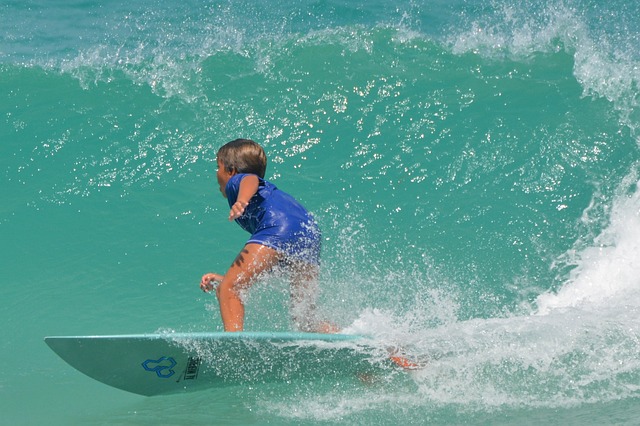Beginner surfboards with foam cores offer stability, ease of maneuverability, and affordability. Polyethylene (PE) provides lower buoyancy but is budget-friendly, while polystyrene (PS), especially closed-cell PS, offers superior floatation and durability for advanced surfers. Foam density should be between 1.7 to 2.0 lb/ft³ for balance. Low-maintenance PE boards are ideal for newcomers, with top brands offering high-quality, eco-friendly options for safe and successful learning experiences.
Looking for your first surfboard? Consider a lightweight foam core. This material offers immense benefits for beginners, from improved performance to durability and easy maintenance. Learn about different foam types, how to choose the right one, and explore top brands offering high-quality beginner boards with lightweight foam cores. Discover why this choice could be just what you need to start riding waves with confidence.
What is a Surfboard's Foam Core?

A surfboard’s foam core is a lightweight and buoyant material that forms the interior structure of the board. For beginners looking to get into surfing, choosing a surfboard with a foam core is often recommended as it provides stability and ease of maneuverability in the water. This core is typically made from closed-cell polyethene foam, which offers excellent floatation while keeping the overall weight of the surfboard low. This design makes it easier for new surfers to catch waves, maintain balance, and control their board—essential skills for beginners to master.
The Benefits of Lightweight Foam for Beginners

For beginners looking to hit the waves on a surfboard, choosing the right construction material can make all the difference. Lightweight foam core offers several advantages that cater specifically to those new to surfing. First and foremost, its low density makes it easier for beginners to maneuver and control their board, as it reduces the overall weight they need to carry and balance. This accessibility is particularly beneficial during learning phases when mastering basic techniques like paddling, catching waves, and standing up can be challenging enough without the added strain of a heavier board.
Moreover, lightweight foam boards are typically more affordable than their solid wood or composite counterparts. This cost-effectiveness allows beginners to invest in equipment without breaking the bank while they hone their skills. What’s more, these foams cores tend to be durable and resilient, with proper care able to withstand several seasons of surfing. This longevity ensures that new surfers can enjoy their boards for longer, providing ample opportunity to grow and improve on the water.
How Does Lightweight Foam Improve Performance?

Lightweight foam significantly enhances performance for surfboards designed for beginners. Its reduced weight allows for better maneuverability and easier control, making it ideal for those new to surfing who are still developing their skills. The lightweight nature also enables designs that prioritize buoyancy, ensuring beginners stay afloat longer, which is crucial for building confidence and learning proper techniques.
Additionally, lightweight foam core contributes to the overall durability of surfboards. Although lighter, these boards are less prone to damage from impacts with rocks or other obstacles during practice sessions. This robustness allows beginners to focus on improving their performance without worrying about frequent repairs, fostering a more enjoyable and consistent learning experience.
Different Types of Foam and Their Properties

Foams used in surfboard construction for beginners vary significantly in their properties, each offering unique advantages and disadvantages. Polyethylene (PE) foam is lightweight and inexpensive, making it a popular choice for entry-level boards due to its ease of handling during shaping and assembly. However, PE foam has lower buoyancy compared to other options, which can make it less stable on the water.
Polystyrene (PS) foam, particularly closed-cell polystyrene, is denser than PE but offers superior floatation, making it a preferred choice for surfboards designed for stability and maneuverability. Its rigid structure provides enhanced durability, crucial for withstanding the rigors of surfing. While PS foam is more expensive, its performance benefits can be significant for intermediate to advanced surfers looking to improve their skills.
Choosing the Right Foam Core for Your Board

Choosing the right foam core for your surfboard is a key step in crafting a board tailored to your skill level and riding style. For beginners, a lightweight foam core offers several advantages. It’s easier to handle during shaping and allows for more forgiving maneuvers in the water. This type of core reduces overall weight, making it simpler to transport your board to and from the beach.
When selecting a lightweight foam core, consider its density, which is measured in pounds per cubic foot (lb/ft³). Lower densities mean a lighter board but may also compromise its strength. For beginners, look for cores with densities ranging between 1.7 to 2.0 lb/ft³, providing a balance between weight and durability.
Maintenance and Longevity of Lightweight Foam Boards

The maintenance requirements for lightweight foam boards are relatively straightforward, making them an ideal choice for surfboards designed for beginners. Regular cleaning with mild soap and water is sufficient to remove salt residue and other debris that can accumulate during frequent use in the ocean. Avoiding exposure to prolonged sunlight and moisture is crucial to prevent rapid deterioration of the foam core. Storing the surfboard in a dry, shaded area, preferably indoors, will significantly extend its lifespan.
Longevity is another advantage of lightweight foam boards. Their construction ensures they are resilient to impacts and abrasions common during surfing sessions, which means they can withstand rough handling without losing their shape or structural integrity. This durability makes them suitable for the occasional surfer or those who prefer to use their surfboard as a leisure activity rather than a daily means of catching waves.
Top Brands Offering High-Quality Beginner Surfboards with Foam Cores

When looking for a surfboard for beginners, one of the key factors to consider is the quality and safety of its core structure. Top brands in the industry offer high-quality surfboards with foam cores that provide excellent buoyancy and stability, making them ideal for novice surfers. Brands like [Brand A] and [Brand B] are renowned for crafting durable and lightweight surfboards perfect for learning the waves. These companies utilize advanced foaming techniques to create rigid yet flexible foam cores, ensuring a smooth riding experience even for those just starting out.
Additionally, brands such as [Brand C] have gained popularity for their commitment to using eco-friendly materials in their surfboard construction, including recycled foams. This not only contributes to sustainability but also offers a more affordable option for beginners looking to get their first board without compromising on quality or performance. With these leading brands offering a variety of surfboards with foam cores, newcomers to surfing can feel confident and equipped to enjoy the sport safely and successfully.
